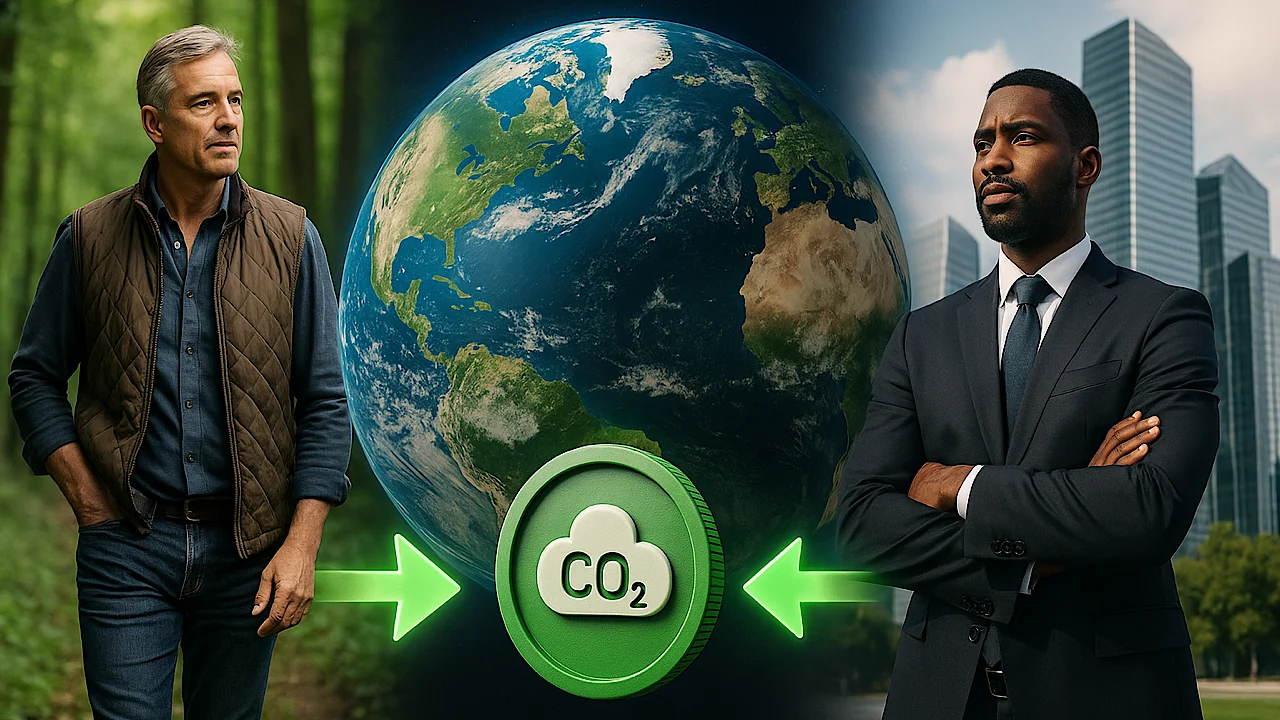
Unlock the truth behind carbon credits and discover how CO2NEX is rewriting the rules—making climate impact fair, transparent, and accessible for all.
A Global Emergency, A Global Opportunity
Climate change isn’t coming—it’s already here. From wildfires and floods to record-breaking temperatures and disappearing ecosystems, the signs are undeniable: our planet is in crisis. But in this growing emergency lies one of humanity’s most powerful tools for healing the Earth—carbon credits.
In a world racing against time, carbon credits offer a way to slow the damage and drive investment directly into climate-positive actions. Whether you own land rich with biodiversity or run a company working to reduce its footprint, carbon credits offer more than just compensation or compliance—they offer a chance to be part of the solution.
So What Exactly Are Carbon Credits?
Let’s break it down simply.
A carbon credit is a certificate that represents the reduction or removal of one metric ton of carbon dioxide (CO₂) or its equivalent in other greenhouse gases. These reductions come from activities like:
- Planting trees or preserving forests
- Switching to clean energy sources
- Adopting regenerative agriculture practices
- Capturing methane or industrial emissions
Once these actions are verified, they can be issued as carbon credits and sold to organizations or individuals looking to offset their emissions.
Think of it like this: if someone is cutting carbon, and someone else is emitting carbon, the credit becomes the bridge between the two—turning pollution into funding for climate solutions.
Why This Blog Exists — and Why You Should Read It
The carbon credit space is filled with confusion, misinformation, and inflated promises. CO2NEX was created to bring clarity, real time transparency, and cut through the noise—whether you’re a landowner with climate-positive land practices, a company looking for real, verified offsets, or simply someone who wants to understand how this all works.
In this post, we’ll walk you through:
- How landowners and farmers can generate income by protecting the planet
- Why businesses are turning to carbon credits—and how to do it right
- The environmental and economic impact of carbon credits
- What’s broken in today’s market—and how CO2NEX is fixing it
By the end, you’ll understand why carbon credits matter, how to get involved, and why CO2NEX is uniquely positioned to drive real change—for everyone.
How Carbon Credits Work (And How They’re Supposed To)
In theory, carbon credits were designed to be elegant in their simplicity—a global incentive system where those reducing emissions get rewarded, and those emitting carbon can take responsibility for their environmental impact by funding those efforts. But like many good ideas, the execution hasn’t always lived up to the vision.
Step-by-Step: The Ideal Carbon Credit Journey
Let’s walk through how the carbon credit system is supposed to work:
1. Carbon Reduction or Removal
Everything begins with a verified action that reduces or removes greenhouse gases from the atmosphere. This could include:
- Planting or protecting forests
- Switching to renewable energy
- Capturing methane from landfills or farms
- Improving soil through regenerative farming
Each of these activities helps pull carbon out of the air or prevent future emissions.
2. Measurement & Verification
Next, these actions must be measured and verified by independent, trusted third parties. This is where many systems falter. Without reliable data, carbon credits can be overestimated, inflated, or even completely fabricated. That’s why transparency and verification standards are the backbone of any trustworthy credit system.
3. Issuance of Carbon Credits
Once verified, carbon credits are issued—each representing one metric ton of CO₂ equivalent removed or avoided. These credits are tracked on registries to avoid duplication and ensure legitimacy. This is where blockchain and digital traceability can make a major difference.
4. Credit Purchase (Offsetting)
Companies, governments, or individuals looking to offset their own emissions can then purchase these credits. Ideally, this should be a direct, fair transaction—with funds going to the people and projects doing the hard work of protecting the planet.
5. Retirement of Credits
Once a credit is used, it is retired, meaning it can no longer be traded or resold. This ensures accountability and prevents carbon offsets from being double-counted.
So What’s the Problem? Carbon Credits for Landowners and Companies
The process sounds clean—but in practice, it’s often murky. Here’s why:
- Middlemen take large cuts, leaving landowners underpaid.
- Verification can be inconsistent, costly, and difficult to access.
- Some credits are low-quality or unverified, leading to greenwashing.
- Lack of transparency has eroded public trust in the carbon market.
Small-scale landowners are often excluded, unable to afford entry.
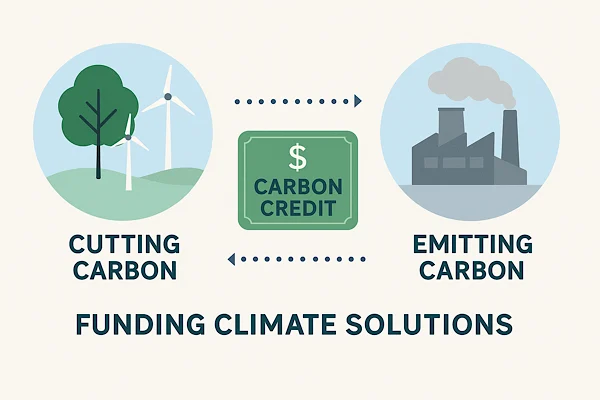
Understanding Carbon Credits
A carbon credit represents one metric ton of carbon dioxide (CO₂) removed or prevented from entering the atmosphere. For landowners, this means that if you’re actively reducing emissions—by preserving forests, planting trees, improving soil health, or restoring natural ecosystems—you can quantify that impact, convert it into carbon credits, and sell those credits to individuals or companies seeking to offset their emissions.
Examples of credit-generating land activities:
- Reforestation & Afforestation – Planting trees in degraded or unused areas.
- Forest Conservation – Avoiding deforestation and protecting existing forests.
- Regenerative Agriculture – Using no-till practices, cover crops, rotational grazing, etc.
- Wetland & Grassland Restoration – Enhancing carbon-sequestering.
- Agroforestry – Integrating trees and crops for long-term climate benefits.
🌍 Global Carbon Credit Market Highlights
- Market Valuation: The global carbon credit market was valued at approximately $479.41 billion in 2023 and is projected to grow at a compound annual growth rate (CAGR) of 39.4% from 2024 to 2030.
- Compliance Market Dominance: In 2023, the compliance segment accounted for 98.80% of the total carbon credit market revenue, underscoring the significant role of regulatory frameworks in driving demand.
- Future Projections: The carbon offset/carbon credit market is expected to reach $1,602.7 billion by 2028, growing at a CAGR of 31.0% from 2023 to 2028.
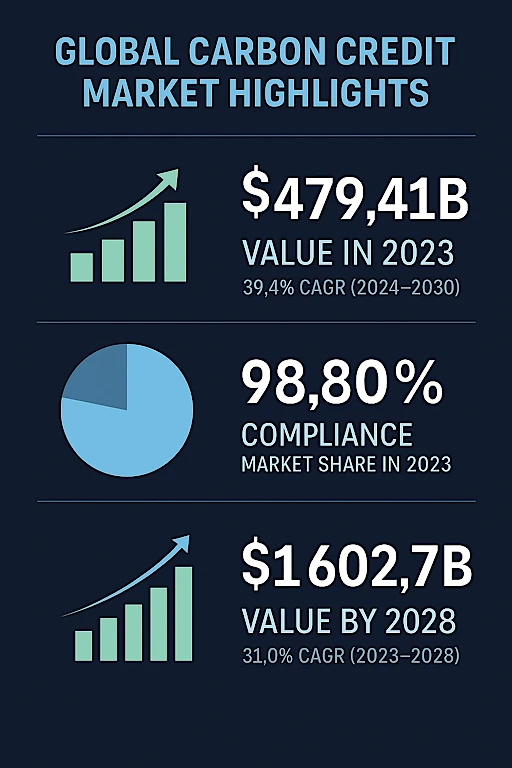
Section 1: For Landowners – Turning Stewardship into Sustainability
At CO2NEX, we believe that the people protecting our land should be the first to benefit from the green economy. Whether you’re a farmer, forest steward, or indigenous landholder, your efforts to preserve and restore the environment can now become measurable, marketable, and meaningful—both for your income and for the planet.
Benefits for Landowners
1. Economic Incentives
Selling carbon credits opens a new stream of income—often with less volatility than traditional agriculture. These payments reward the ecological services you’re already providing or capable of expanding. CO2NEX ensures that middlemen don’t take the lion’s share. As a nonprofit, we are structured to ensure maximum payout directly to landowners.
- Unlock value from land conservation
- Diversify income in uncertain economic times
- Attract funding and recognition for rural innovation
2. Environmental Impact
Beyond income, your participation supports ecosystem resilience and biodiversity. Healthier soils, cleaner water, and robust native species thrive where carbon is being sequestered. Landowners become climate defenders, preserving legacies for generations to come.
Getting Started with CO2NEX
We’ve streamlined the process to be accessible and transparent for landowners around the world.
Step 1: Project Registration
- Sign up through the CO2NEX Platform
- Submit basic land information (location, size, current practices)
- Our team assesses eligibility and outlines your credit potential
Step 2: Baseline & Planning
- We work with you (or your chosen project developer) to establish a baseline of your carbon output or sequestration potential
- You’ll receive guidance on actions that can maximize credit generation
Step 3: Verification & Certification
- CO2NEX partners with trusted third-party verifiers and auditors
- Once verified, your project is officially certified and listed on our registry
- You can now sell credits to buyers in our transparent marketplace
Step 4: Payments
- You receive payment directly—no hidden cuts, no delays
- Payments can be set as lump sums or recurring depending on project terms
Success Stories: Impact in Action
Rodrigo & Ana – Brazil, Cerrado Biome
The couple transitioned from conventional soy farming to rotational regenerative grazing. Within two years, they earned their first carbon credits, increased biodiversity on their land, and received international recognition for carbon-negative beef.
Dine Nation Forestry Program – United States
By preserving 13,000 acres of ancestral woodland and planting native tree species, this sovereign tribal project earned sustainable revenue while reintroducing wildlife and preserving cultural practices.
AgroEco Farms – Kenya
Through agroforestry and soil carbon improvements, this small collective of female farmers turned once-barren land into fertile income-generating fields—proving that even small plots can create global impact.
Whether you manage 10 hectares or 100,000, you have the power to shape climate resilience. CO2NEX is here to ensure your stewardship is honored, valued, and rewarded.

🌱 Opportunities for Landowners
- Agriculture and Forestry Market Growth: The carbon credit market for agriculture, forestry, and land use was valued at $6.28 billion in 2023 and is anticipated to reach $97.1 billion by 2033, growing at a CAGR of 31.49%.
- Soil Carbon Credit Valuation: In the UK, verified soil carbon credits are currently estimated to be worth £60–£80 per ton, highlighting the financial potential for landowners engaging in verified carbon sequestration practices.
- Government Support for Small Landowners: The U.S. government has allocated $150 million to assist small forestland owners in participating in carbon credit markets, aiming to make the market more inclusive and accessible.
Section 2: For Company Owners – Investing in a Sustainable Future
Why Companies Should Care
Corporate Responsibility:
Modern consumers are increasingly prioritizing sustainability. A study by Harvard Business Review indicates that younger generations view sustainability as a baseline requirement for their purchases, emphasizing the importance of trust and environmental responsibility in business practices.
Regulatory Compliance:
With the global push towards net-zero emissions, companies are facing stricter environmental regulations. Carbon credits offer a flexible mechanism to meet these requirements, allowing businesses to offset emissions they cannot eliminate entirely.
Economic Advantages
Market Growth:
The carbon credit market is experiencing significant growth. Valued at USD 114.8 billion in 2024, it’s projected to reach USD 474.2 billion by 2034, driven by increasing corporate sustainability commitments and ESG adherence.
Brand Value:
Investing in carbon credits enhances a company’s brand reputation. Demonstrating environmental responsibility can lead to increased customer loyalty and a competitive edge in the market.
How to Participate
Purchasing Credits:
CO2NEX provides a transparent platform for companies to purchase verified carbon credits. Each credit is traceable, ensuring that your investment contributes to genuine emission reduction projects.
Integrating into Business Models:
Incorporate carbon credits into your sustainability strategy by:
- Offsetting unavoidable emissions.
- Supporting projects aligned with your company’s values.
- Communicating your commitment to sustainability to stakeholders.
Case Studies:
- EcoTech Inc.: Integrated carbon credits into their operations, resulting in a 20% increase in customer engagement due to enhanced brand image.
- GreenLogistics: Offset their transportation emissions through CO2NEX, leading to compliance with new environmental regulations and opening doors to eco-conscious clients.
Section 3: The Importance of Carbon Credits for Planetary Health
Combatting Climate Change
Emission Reductions:
Carbon credits incentivize the reduction of greenhouse gas emissions by assigning a monetary value to emission reductions, encouraging investment in sustainable practices.
Supporting Global Goals:
Carbon credits align with international climate agreements, such as the Paris Agreement, by providing mechanisms to achieve emission reduction targets.
Protecting Ecosystems
Biodiversity Conservation:
Nature-based carbon credit projects often lead to the preservation of habitats and endangered species, contributing to biodiversity conservation.
Community Benefits:
These projects can support local communities through job creation, sustainable development, and by providing alternative income sources, fostering economic resilience.
Future Outlook
Technological Innovations:
Advancements in carbon capture and storage technologies are enhancing the efficiency and scalability of emission reduction efforts.
Policy Developments:
Emerging policies are expected to further standardize carbon credit markets, increasing their reliability and encouraging broader participation.
Section 4: Challenges in the Current Carbon Credit System
Lack of Standardization
The absence of universal standards leads to inconsistencies in credit quality, making it challenging for buyers to assess the true impact of their investments.
Verification Issues
Ensuring the actual impact of carbon credit projects remains a challenge, with some projects failing to deliver the promised emission reductions.
Market Accessibility
Small landowners and developing countries often face barriers to entering carbon markets due to high costs and complex procedures.
Potential Solutions
- Improved Regulations: Implementing stronger oversight and clearer guidelines can enhance the credibility of carbon markets.
- Technological Tools: Utilizing technology for better monitoring and verification can increase transparency.
- Inclusive Platforms: Platforms like CO2NEX aim to make carbon markets more accessible and transparent, empowering a broader range of participants.
Section 5: CO2NEX – Pioneering a Sustainable Future
Our Mission
CO2NEX is committed to creating a transparent, accessible, and equitable carbon credit platform that empowers both landowners and companies to contribute to climate solutions.
What Sets Us Apart
- Nonprofit Model: Our focus is on environmental impact over profit, ensuring that the majority of funds go directly to project developers.
- Transparency: We ensure all projects are thoroughly vetted and verified, providing confidence to buyers and sellers alike.
- Community Engagement: We actively involve local communities in carbon credit projects, promoting sustainable development and shared benefits.
- For Landowners: Register your project with CO2NEX to start earning from sustainable practices.
- For Companies: Purchase verified carbon credits and integrate them into your sustainability strategies.
- For Everyone: Support and spread awareness about CO2NEX’s mission to foster a more sustainable future.
Conclusion
Carbon credits serve as a vital tool in the global effort to combat climate change, offering economic and environmental benefits to both landowners and companies. CO2NEX stands at the forefront of this movement, providing a transparent and equitable platform for all stakeholders.
Join CO2NEX today—whether by registering a project, purchasing credits, or simply learning more—to be part of the solution for a sustainable future.!
- All Posts
- Blog
- Carbon Credit Education
- Carbon Markets & Climate Solutions
- Climate Solutions
- Green Income Opportunities for Landowners
- Sustainability & Green Finance
- Sustainable Land Use & Agriculture
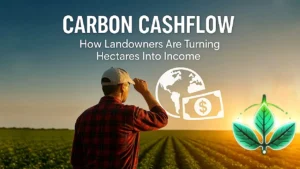
Carbon credit programs for landowners: Learn how to profit sustainable land use. Includes registration, earnings, verified platforms like CO2NEX.
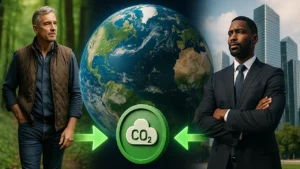
Learn how carbon credits for landowners & companies connect to fight climate change. CO2NEX makes it transparent, fair & impactful...
